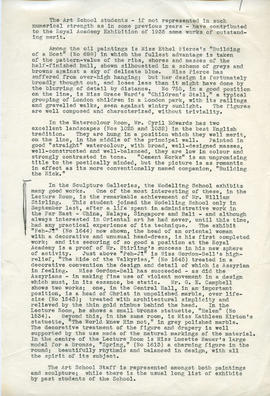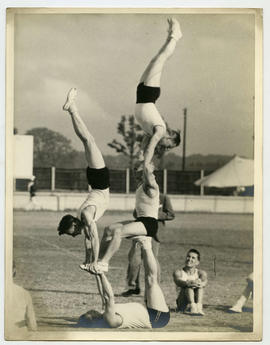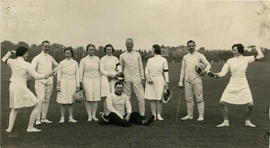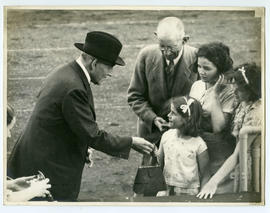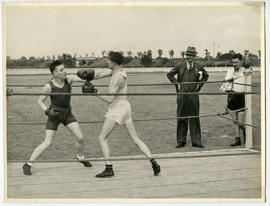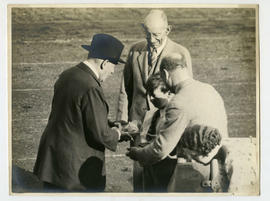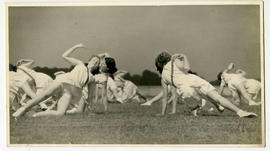Identity area
Reference code
Title
Date(s)
- 1891-1970 (Creation)
Level of description
Extent and medium
Context area
Name of creator
Administrative history
The Young Men's Christian Institute became Regent Street Polytechnic when the Polytechnic Scheme of Administration was approved by an Order in Council on 23 June 1891. The Scheme, which was drawn up under the auspices of the Charity Commissioners, established a new governing body and ensured annual funding from the City Parochial Foundation.
The Scheme changed the name and status of a well-established and rapidly expanding institution. The Young Men's Christian Institute (originally the Youths' Christian Institute), founded and funded by Quintin Hogg (1845-1903) in Covent Garden, had moved to 309 Regent Street in 1882, and gradually assumed the title of Polytechnic, which came from the name of the building, well known to the public as the former home of the Royal Polytechnic Institution. Hogg's vision was to provide for the athletic, intellectual, social and religious needs of young men, and to this end he provided a range of sporting and social facilities as well as an increasing range of educational and vocational classes. His institution attracted a great deal of attention from the technical education lobby, and also from Henry Cunynhame, one of the Charity Commissioners, whose reports prompted the Commission's decision to devote a substantial proportion of the revenue created by the City of London Parochial Charities Act (1883) to endowing Regent Street and establishing a network of polytechnics on the Regent Street model throughout the metropolis. The City Parochial Foundation (CPF) was established in 1891 to administer the funds. The 1891 Scheme, with some amendments, shaped the government of Regent Street Polytechnic until 1970. From 1893 the Polytechnic also received grants from the Technical Education Board (TEB) of the London County Council. The London Polytechnic Council (LPC) was established to inspect and co-ordinate the work of the polytechnics. Both the TEB and the LPC were abolished following the London Education Act in 1904, when the LCC took over responsibility for education in the metropolis. By then it had overtaken the CPF in provision of financial support for the polytechnics, and continued to fund and to manage them until 1965, when it was succeeded by the Inner London Education Authority (ILEA). The maintenance grant for Regent Street was negotiated on an annual basis. CPF funding, which remained at the level established by the 1891 Scheme, was withdrawn from the polytechnics in 1962.
The establishment of a formal management structure and the increasing dependence upon outside funding, which brought external accountability and loss of independence, eventually led to the breakdown of Hogg's unified vision. The educational side, which dealt with students and the organisation of classes, became separate from the Institute side, which catered for members of the social and sporting clubs, with the eventual decline of the Institute. This was a slow process, however, with many individuals participating in the full range of activities, and the Polytechnic remained remarkably unchanged until after World War Two. When Hogg died in 1903, he was succeeded as President by Kynaston Studd, who remained in office until his death in 1944, and did much to continue the traditions of the founder. Two major appeals were launched to support expansion, the first for the rebuilding of no 309 Regent Street in 1910-1912, and the second to build the Polytechnic Extension building in Little Titchfield Street, which was formally opened in 1929. Both buildings continued to provide sporting and social facilities for members of the Institute as well as workshops and classrooms for students of the Education Department.
The Education Department provided a wide range of courses, with a rapid expansion of commercial subjects alongside the original trade and technical classes. Courses ranged from post-elementary school entry for craft and technical training at 13 to preparation for University of London external degrees. Most teaching was in the evening and part-time, though day classes increased throughout the period. Following World War Two there was a rapid growth in the demand for further education and training, which was reorganised following the White Paper on Technical Education (Cmnd 9703) in 1956. The variety of levels of work at Regent Street meant that it was designated a regional college rather than a college of advanced technology, after which the governors decided to reduce the proportion of lower level work. Following the establishment of the Council for National Academic Awards (CNAA) in 1964, a number of degree courses were approved and became operational. In 1960 the London County Council announced a plan to turn Regent Street into a tri-partite federal college by adding a new College of Architecture and Advanced Building Technology (CAABT) and also a College of Engineering and Science (CES). The existing commercial subjects would remain centred on 309 Regent Street. CAABT was allocated the Luxborough Lodge site in Marylebone Road and CES a site in New Cavendish Street. Both schemes suffered prolonged delays and the new buildings were not finished until 1970. Meanwhile the publication of the White Paper, 'A Plan for Polytechnics and Other Colleges' (Cmd 3006), had announced the creation of some 30 polytechnics throughout the country to form what became called the public sector of the binary system of higher education. The 13 existing colleges managed by ILEA were to be reorganised into five. Holborn College of Law, Languages and Commerce was merged with Regent Street to form PCL (the Polytechnic of Central London). At a ceremony on 21 May 1971, the Lord Chancellor Lord Hailsham, grandson and namesake of Quintin Hogg, opened the new buildings and designated the new institution.
Repository
Archival history
Immediate source of acquisition or transfer
Content and structure area
Scope and content
Appraisal, destruction and scheduling
Accruals
System of arrangement
This Fonds is currently being catalogued. Newly catalogued material will be added on a regular basis; in the meantime we have endeavoured to make available an outline of the Fonds. Please contact the Archivist for more information.
The Fonds has been sub-divided into the following sections:
RSP/1 Governing Body and Committees
RSP/2 Administrative records
RSP/3 Financial records
RSP/4 Education records
RSP/5 Publications
RSP/6 Events
RSP/7 Photographs and paintings
RSP/8 Student Body
RSP/9 World War One
Conditions of access and use area
Conditions governing access
Conditions governing reproduction
Language of material
- English


